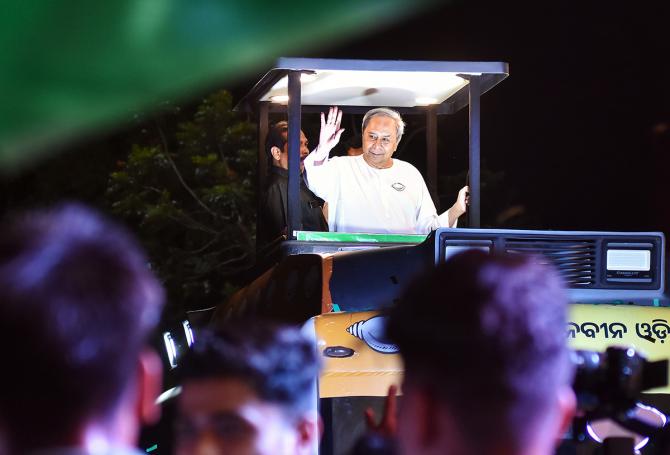The Odisha government told the assembly over 40,000 workers migrated from the state last year, with the highest number -- 26,151 -- from Balangir.

Last November, Bibhu Suna, 27, chose not to join his uncle on the annual migration to Hyderabad. He stayed back in Turekela, part of the Kantabanji assembly constituency, and now works as a salesman at the Balangir district headquarters. "Working at a brick kiln in Hyderabad in the COVID-19 pandemic year was a hellish experience," Suna recounted.
A sleepy town 80 km from Balangir, Kantabanji comes alive after Nuakhai, a harvest festival in western Odisha in September-October. That's when thousands of families from three blocks in Kantabanji leave for Telangana, Andhra Pradesh, Maharashtra, etc to work at brick kilns and construction sites. But this year, the buzz came early and for a different reason.
Naveen Patnaik is contesting from the seat, in addition to his traditional Hinjili constituency in Ganjam, which too suffers from migration. This has raised hopes among residents for a positive change in their fortunes.
Decades-old issue
While people from Ganjam migrate to Surat in Gujarat and Maharashtra due to lack of jobs in the area, poverty, poor irrigation, and natural disasters force those from western Odisha to seek work in southern states, reasons Umi Daniel, head of the migration unit of Aide et Action.
Activist Sanjay Mishra says migration dates back to the Odisha famine of 1866, with frequent famines since then compelling people to mortgage and sell their land and valuables.
In November last year, the Odisha government told the assembly over 40,000 workers migrated from the state last year, with the highest number -- 26,151 -- from Balangir. In the past three years, 153 workers died while working outside the state.
However, Mishra says nearly 200,000 tickets are sold at Kantabanji station between November and December. People are lured with advance payments of Rs 30,000 to Rs 50,000, which they mostly use to pay off loans and arrange marriages for their daughters.
They typically migrate for six to eight months until the paddy plantation season begins, as told by sardars (labour contractors). There is a chain of contractors from village-level agents up to the destinations, who get commissions as much as Rs 10,000 for a worker.
"Most of these licensed contractors are political leaders, and it's their family business," said Suratha Behera, an Aam Aadmi Party leader contesting against Patnaik.
Abhiram Dharua, a Forward Bloc candidate, agrees. Dharua was in Class 5 in 1992, when he accompanied his migrant parents to Hyderabad. "I harvested only 4-5 quintals of paddy last season due to lack of irrigation. It's difficult to manage a family of 13," said Dharua, who has declared assets of Rs 6,500 in hand in his affidavit.
In January, Patnaik inaugurated the much-delayed Rs 2,723 crore (Rs 27.23 billion) Lower Suktel irrigation project in arid, drought-prone Balangir, which the government claims will benefit 203 villages. But the water doesn’t reach the higher areas of Kantabanji.
When COVID-19 broke out, more than 1 million workers returned to Odisha, and 773,000 of them were provided work under the Mahatma Gandhi National Rural Employment Guarantee Act. However, locals in Kantabanji argue this is not a permanent solution.
"The only cure for the migration situation is to create jobs," said Samarendra Mishra, Congress candidate from the Balangir assembly seat.
The constituency has everything needed for industrial development -- good roads, a railway station under re-development, and Utkela airport in Kalahandi just an hour-and-a-half away. "What is lacking is the government’s commitment," said Behera.

Ray of hope
Patnaik faces a three-cornered contest not just in the constituency but in the whole of western Odisha. While the Bharatiya Janata Party swept all five Lok Sabha constituencies in the region -- Balangir, Kalahandi, Baragarh, Sambalpur, and Sundargarh -- the Congress has been a formidable opponent.
Patnaik's candidature from Kantabanji, held by four-time Congress legislator Santosh Singh Saluja, could be a strategy to counter the Opposition's influence, says Behera, demanding a white paper on the migration situation in Hinjili.
The BJP has made the issue a key poll pitch, with Narendra Modi fronting the attack against Patnaik. In its manifesto, the BJP promises to provide a 'one nation, one ration card' scheme for migrants and create over 51,000 jobs by setting up three integrated textile parks and a handloom export park.
Activist Mishra says legalising migration would help because it would ensure a direct transfer of money into the accounts of both the migrants and the middlemen involved.
The Balangir Lok Sabha constituency and assembly segments under it go to the polls on May 20, and Daniel says the votes of migrants will make an impact. In the May 13 elections, the migrant-hit Berhmapur seat, in Ganjam district, saw a low voter turnout of 63 per cent, against 66 per cent in 2019.
Highlighting the plight of labourers at brick kilns, Suna says it is unlikely that owners will allow the workers to return to cast their votes. "Those who do return would have to pay for their travel. Political parties and agents might help."
Dharua says he is not contesting to win. "I'm visiting every village, highlighting farmers' plights and promising solar panels in the agriculture fields if elected," he said. He hopes Patnaik will announce a special package for the area.
Congress leader Mishra says: "The whole state belongs to the CM, and he need not contest an election to announce a package."











